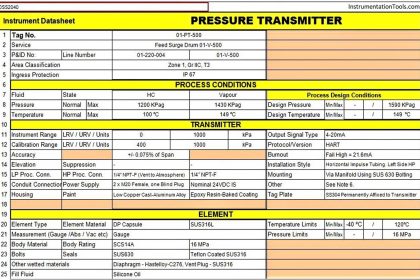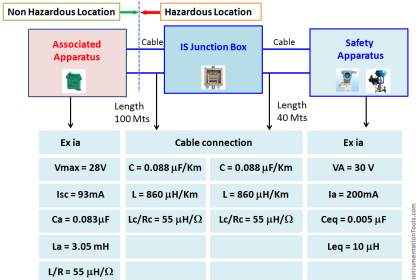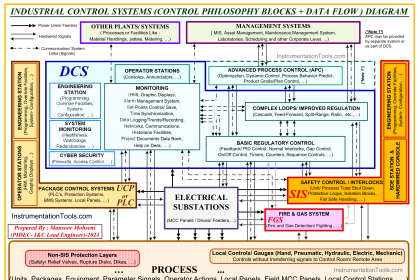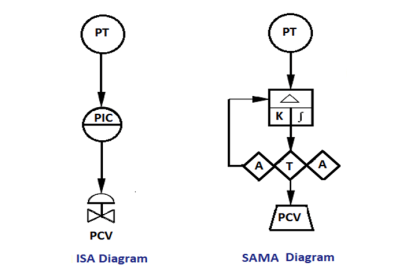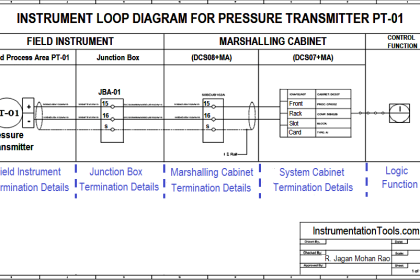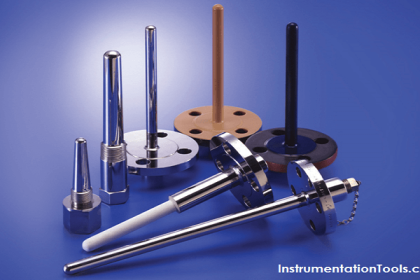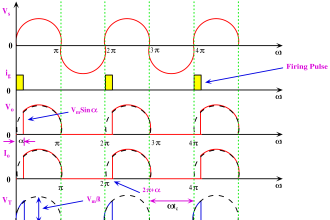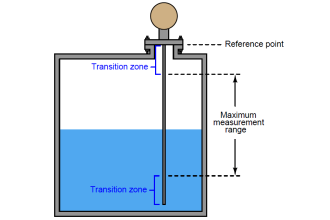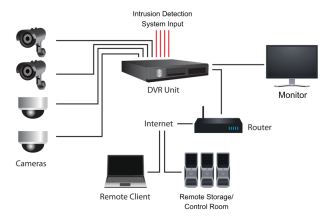Instrument Data Sheet is a document containing specification and information of an instrument device.
Instrument DataSheet
Instrument DataSheet specifies general information of instrument such as tag number identification, service description, location (line number/equipment number), P&ID number or drawing number reference, process data (if applicable), calibrated range (if applicable), material, performance details (such as accuracy, linearity – if applicable), hazardous certification (for electrical device), accessories required, etc. The details of information in data sheet may differ among each types of instrument such as transmitter, switch, gauge, control valves.
Reference document: Piping and Instrumentation Diagram (P&ID), Heat and Material Balance (HMB), line list, instrument specification, piping specification, calculation, vendor catalog.
Preparing a data sheet requires some document/drawing references.
The following steps describe the work flow:
P&ID
It provides general information such as instrument tag number, service description, line number/equipment number, P&ID number.
Process data
Some of the following process data should be available for selection of instrument; fluid type, fluid state (gas/liquid), design pressure, operating pressure, design temperature, operating temperature, flow rate, density, viscosity, specific gravity, ratio specific heat (gas), molecular weight (gas).
However, the information of process data which is required to be specified in the data sheet varies depends on the instrument type. For example, a pressure gauge data sheet does not require ratio of specific heat.
By knowing those process data, Instrument engineer may select material of instrument, calibrated range, body rating, etc. Process data can be obtained from process discipline document named “Heat and Material Balance” (HMB).
Other way, instrument engineer may look to the line list, also issued by process discipline, to get general process data. However, compared to HMB, only limited process data is provided in line list document.
Project specification
Company has specification which details minimum requirement for instrumentation. In addition, it also provides standard that shall be applied to instrument in order to have uniform specification for certain instrument throughout the plant.
This is intended to minimize the spare part and tools, also to give ease of maintenance.
Calculation
Some instrument need to be calculated to have a proper size. This calculation is required prior data sheet preparation. Control valve, pressure safety valve, orifice plate, thermowell are some of instruments which need to be calculated.
Vendor catalog
It is recommended to refer vendor catalog during data sheet preparation to ensure that the device is available on the market. Skipping this activity could result difficulties in finding the instrument on the market during procurement phase.
If the instrument is not available on the market, it could change the design, not only the instrument design but also could revert back up to process design. Not only re-work, it also could result to project delay.
Code and Standard. Last but not least, cross check to the related code and standard is needed although this issue mostly has been covered in project specification.
Purpose of Instrument Datasheet
When the data sheet completed, it is attached to requisition which to be sent to several vendors. Vendors will offer their quotation with various model and manufacturer among the offers. It is an instrument engineer responsibility to evaluate all quotation and determine which offer is technically acceptable.
Having been considered its technical and commercial aspects, the instrument is purchased. Following the purchase order, vendor will submit supporting document and drawing. Based on vendor data, instrument data sheet may be updated to accommodate details to make the data sheet “as-built”.
Finally, data sheet along with its supporting vendor data are stored in library or document control and will be referred during construction, operation and maintenance.
Instrument datasheets are very important. Every EPC has, usually, it’s own templates and in some cases not all the information are reported. A good thing to do is to use ISA 20 templates that are quite complete. This ISA 20 templates are constantly reviewed updated by ISA committees.
More information can be indicated, more easy will be to purchase the correct instruments. This will also have a positive impact on field (i.e. purchase spare instruments or make a substitution of someone).
What is the difference between instrument specification and instrument data sheet?
The terms of instrument specification and instrument data sheet are used interchangeably by some practitioner. Both are referred as the documents or information sheet which specifying the details of instrument. You often see manufacturers use the word “specification” in their product flyer and some time you get “data sheet” in different manufacturer product sheet.
For those who involve in the project, instrument specification and instrument data sheet are two different documents. Instrument specification is a document which limit the boundary of instrument. It says the general rule of how to specify an instrument to be used. Meanwhile, information in data sheet is much more detail and much more specific to suit the application.
The following example provides how the specification and data sheet talk about instrument range:
Specification:
“The range of instrument must be selected so that maximum value of process variable does not exceed 90% of calibrated range”
Data Sheet:
“0 – 100 barg” (in which case the maximum process pressure is 90 barg)
Instrument specification is to be generated first and based on this document we can derived the data sheet while getting other information from others documents during preparation of instrument datasheet.
